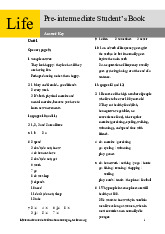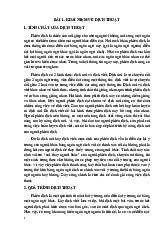





Preview text:
LESSON PLAN
TIẾNG ANH 11 FRIENDS GLOBAL
UNIT 3: SUSTAINABLE HEALTH
LESSON 3G- SPEAKING: PHOTO DESCRIPTION I. OBJECTIVES
By the end of this lesson, Ss will be able to: 1. Knowledge
- Gain useful language for describing photos of a sports class.
- Gain useful language for expressing their opinions. 2. Competences
- Describe photos of a sports class.
- Offer their personal opinion on matters related to health and fitness.
- Recount a personal experience related to health and fitness.
- Identify key details in students’ answers to related questions.
- Develop self-study skills, collaborative skills and communicative skills. 3. Personal qualities
- Build their awareness of caring about their appearance.
- Be collaborative and supportive in pair work and teamwork.
- Actively join in class activities. II. MATERIALS
- Grade 11 textbook, Unit 3, Speaking
- Computer connected to the Internet - Projector / TV - PowerPoint Unit 3G III. PROCEDURES
1. ACTIVITY 1: WARM-UP / LEAD-IN (5 mins) a. Objectives:
- Introduce the new lesson and set the scene for Ss to acquire new language.
- Get students' attention at the beginning of the class.
- Activate Ss’ background knowledge.
- Students can gain more confidence and interest in the lesson. b. Content:
- Word Association (Activity) - Exercise 1. (p.44) c. Products:
- Ss work in groups, say aloud their answers, and express their opinions. d. Organisation
TEACHER’S AND STUDENTS’ ACTIVITIES CONTENT Word Association (3 mins) - Ss work in groups.
- Each group takes turns to say a word associated to the
given topic “Fitness exercise”.
- If a group fails to say the word in 5 seconds, that group is eliminated.
- T can give examples by using the topic “The Body” on the slide.
- The last group remaining wins the game.
- T monitors to make sure the game is fair.
Exercise 1: Look at the photos. Which fitness class would you prefer to do? Why? (2 mins)
- T focuses Ss’ attention on the photos.
- Students discuss the questions in pairs.
- A few students volunteer to share their ideas with the class. e. Assessment
- Teacher observes the groups and give feedback.
- T and other students give feedback to individual answers.
2. ACTIVITY 2: PRE-SPEAKING (25 mins) a. Objectives:
- Ss gain vocabulary for identify people in photos and speculate about photos.
- Ss understand the structure of giving a photo description. b. Content:
- Pre-teach vocabulary related to the topic. - Exercise 2 (p.44) - Exercise 3 (p.44) - Exercise 4 (p.44) - Exercise 5 (p.44) c. Products:
- Ss know how to pronounce the new words precisely and use them in appropriate contexts.
- Ss can do the gapped-sentence tasks successfully. d. Organisation
TEACHER’S AND STUDENTS’ ACTIVITIES CONTENT
Vocabulary pre-teaching (5 mins)
- Teacher introduces the vocabulary. New words:
- Teacher explains the meaning of the new vocabulary 1 vest-top /vest tɒp/ (n.) by pictures. 2 leggings /ˈleɡɪŋz/ (n.)
- Teacher checks students’ understanding and conduct 3 stripy /ˈstraɪpi/ (adj.)
oral drill chorally and individually. 4 rope /rəʊp/ (n.)
- Ss take notes of the new vocab.
5 climbing frame /ˈklaɪmɪŋ freɪm/ (n.) 6 slide /slaɪd/ (n.)
7 pull-up /ˈpʊl ʌp/ (n.) (v.) = chin-up
8 push-up /ˈpʊʃ ʌp/ (n.) = press-up /pres ʌp /
9 squat /skwɒt/ /skwɑːt/ (n.) (v.)
Exercise 2: Read the Speaking Strategy. Then listen to two students describing the photos in
exercise 1. Which student follows the strategy better? Explain your answer (5 mins)
- T goes through the instructions and Speaking Strategy. Answer:
- T plays the recording so that students can decide who
Student 1. she covers all the points, gives
covers the points in the Speaking Strategy better.
her opinion and her answer is more detailed,
- T checks answers as a class and shows the script for Ss focused and structured. to follow.
Exercise 3: Look at the useful phrases below. Are you more likely to use them for general or
detailed descriptions? (2 mins)
- T goes through the phrases in the table and checks Answers:
their meaning and pronunciation.
For detailed descriptions
- T asks students whether the phrases are for general or detailed comments. - T elicits an answer.
- In pairs, students take turns to describe other class
members using the phrases in exercise 3.
- A few students volunteer to share their descriptions with the class
Exercise 4: Listen again. Which of the underlined phrases from the list below does each student use? (3 mins)
- T goes through the phrases and checks their meanings. Answers:
- T plays the recording again for students to note the
Student 1 it looks like some kind of; or expressions they hear.
maybe; it’s most likely; I’d say that
- Students volunteer to give the answers.
Student 2 I think it’s a fitness class of some
kind; there’s a sort of; or something like that; I would say
Exercise 5: Read question 1 below. Then listen to a student’s answer. Which photo from exercise
1 is he referring to? How do you know? (3 mins)
- T asks students to read the instructions and question 1. Answer:
- T plays the recording for students to answer the
Photo a; the student refers to lots of questions. sunshine and fresh air
Exercise 7: Read questions 2 and 3 below. Then look at phrases a–h. Which phrases would be
useful for each of the questions? (2 mins)
- T asks students to study the questions and then match Answer: them with phrases a–h. 2 b, d, e, g
- T checks answers as a class. 3 a, c, f, h
- With a stronger class, T can elicit more phrases for
introducing an opinion and describing an incident or
event in the past, e.g. I really think that …; I believe that
…; It’s my belief that …; There was one occasion when
…; On one particular day …; A few months back …
Exercise 8: Listen to three students answering questions 2 and 3 from exercise 7. Answer the questions below. (5 mins)
- T goes through the instructions and questions. Answers:
- T plays the recording for students to answer the
1 1: no; 2: yes; 3: maybe questions. 2 2
- T checks answers as a class.
3 a job interview (1), a wedding (2), a friend’s party (3) e. Assessment
- Teacher checks students’ pronunciation and gives feedback.
- Teacher checks students’ understanding of speaking strategy.
- Teacher observes Ss’ writing of vocabulary on their notebooks.
3. ACTIVITY 3: WHILE-SPEAKING (12 mins) a. Objectives:
- Ss describe photos of a sports class.
- Ss offer their personal opinion on matters related to health and fitness.
- Ss recount a personal experience related to health and fitness. b. Content: - Exercise 5. (p.44) - Exercise9. (p.44) c. Products:
- Students discuss with their friends, take notes and give a talk. d. Organisation
TEACHER’S AND STUDENTS’ ACTIVITIES CONTENT
Exercise 6: In pairs, ask and answer the same question about the other photo in exercise 1. (5 mins)
- In pairs, students take turns to ask and answer
1 Do you think the people are enjoying the class?
the question from exercise 5 about the other photo Why do you think so? (photo B).
- They should try to use phrases from exercise 4.
- T monitors and invites some Ss to give their answers.
Exercise 9: Work in pairs. Ask and answer the questions in exercise 7. (7 mins)
- T gives students a minute to plan their answers.
2 Do you think men care as much about their
- T puts students in a different groups/pairs.
appearance as women? Why do you think that?
- Ss take turns to ask and answer the questions.
3 Tell me about an occasion when you wanted to
- T asks a few students to share their ideas with look your best.
the class. (T can use the lucky wheel to choose randomly a student)
- T notes down students’ strength and weaknesses in speaking. e. Assessment
- Teacher observation on Ss’ performance.
4. ACTIVITY 3: POST-SPEAKING (8 mins) a. Objectives:
- Ss can improve their speaking based on feedback. b. Content:
- T’s feedback and peer’s feedback. c. Products:
- Students take notes of their mistakes. d. Organisation
TEACHER’S AND STUDENTS’ ACTIVITIES CONTENT
Feedback and Correction (8 mins)
- T invites some students to give feedback on their
Students’ mistakes in speaking. friends’ speaking.
- T writes sentences with significant errors in them on
the board, without saying who made the errors.
- Ss identify and correct them. e. Assessment
- Teacher observation on Ss’ performance.
- Teacher’s feedback and peers’ feedback. 5. CONSOLIDATION (2 mins) a. Wrap-up
- If T is using the Classroom Presentation Tool, first do the lesson closer to review what has been covered in this lesson.
- T asks students: What have you learned today? What can you do now? and elicits answers: I
can describe photos in detail. I can speculate about a photo and give my opinion of the
activity shown in it. I can describe past personal experiences that are related to the photo b. Homework
- Prepare for the next lesson




